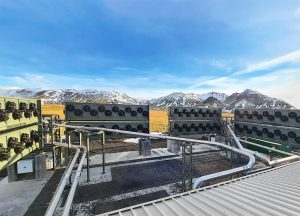Iceland has thrown its hat into the climate change ring in a big way with the introduction of Orca, the world’s biggest direct air capture (DAC). According to the International Energy Association (IEA), DAC “. . . is a technology to capture CO2 from the atmosphere” which “can be permanently stored in deep geological formations or used in the production of fuels, chemicals, building materials and other products containing CO2.” As reported in Gizmodo.com, “. . .the plant can remove 4,000 metric tons of carbon dioxide per year from the atmosphere, powered by hydrothermal energy.”
Although a bit technical,Vice.com offers the following simplified explanation: “The facility is made up of eight air collection containers, each holding several dozen cylindrical fans, which pull in ambient air and filter carbon dioxide from it using a filter. What’s trapped is heated, mixed with water, and pumped deep underground.”
And make no mistake about it, Orca is a state-of-the-art system with a visual appearance that takes on almost mystical properties. As BBC describes it: “As you get closer you see the wall is moving, shimmering – it is entirely made up of huge fans whirring in steel boxes. You think to yourself that it looks like a gigantic air conditioning unit, blown up to incredible proportions.”

Orca, like other DACs, is primarily a response to reduce carbon emissions as charged by the Intergovernmental Panel on Climate Change (IPCC), which stated, “It has been clear for decades that the Earth’s climate is changing, and the role of human influence on the climate system is undisputed.” In concert with this perspective, UN Secretary-General António Guterres said,“Inclusive and green economies, prosperity, cleaner air and better health are possible for all, if we respond to this crisis with solidarity and courage.”
However, DACs are not without critics. Patrick Lavery of the International Flame Research Foundation writes, “Part of the problem with direct air carbon capture is, somewhat paradoxically, the low concentrations of CO2 in air (at around 410 ppm, or 0.04% by volume), and this is one reason why capture from power plants and other heavy industry is vastly more economical, the flue gases being heavily concentrated.”
This is a crucial point because some people have made the contention that our present CO2 concentration is actually quite moderate, and considerably less when using data from a geologic scale, which goes back millions of years. A recent report from The Heartland Institute frames it this way:
“Relative to Earth’s entire record, carbon-dioxide levels are at historically low levels; they only appear high when compared to the dangerously low levels of carbon dioxide that occurred in Earth’s very recent history. The geologic record reveals carbon dioxide has almost always been in Earths’ atmosphere in much greater concentrations than it is today. For example, 600 million years ago, when history’s greatest birth of new animal species occurred, atmospheric carbon-dioxide concentrations exceeded 6,500 parts per million (ppm) — an amount that’s 17 times greater than it is today.”
There are those that refute this assertion that there have been higher concentrations of CO2 in our geologic past. Samples from ice cores show that we have roughly more than double the CO2 in our atmosphere compared to records of nearly 1 million years ago, though that is a more limited time scale.
However, and many independent scientists have made this point, we may have causality mixed up. In other words, it may just be that a warming climate, primarily driven by natural oceanic heating cycles that release CO2 into the atmosphere. In this scenario, CO2 is a lagging indicator, trailing temperature by several thousand years. But new research is showing that this may not be the case. As a recent Scientific American article reports, a team of scientists “show CO2 lagged temperature by less than 200 years, drastically decreasing the amount of uncertainty in previous estimates.”
In any case, Orca is up and running, and likely presages the use of similar technologies to try to get a handle on atmospheric carbon. But it’s a tall order for Orca and future DACs. As Vice.com points out, “Carbon removal technologies will need to scale up exponentially, and extremely quickly, to remove the 100 to 1000 gigatons of CO2 from the atmosphere that the Intergovernmental Panel on Climate Change (IPCC) says is necessary by 2100 to minimize catastrophic climate change.”
Unsurprisingly, some scientists are optimistic about the DAC approach, feeling they are the only way out of our warming atmosphere. Ajay Gambhir, senior researcher at the Imperial College Grantham Institute for Climate Change states, “The number of things that would have to happen without direct air capture are so stretching and multiple it’s highly unlikely we can meet the Paris Agreements without it.” And David Morrow, the Director of Research at the Institute for Carbon Removal Law and Policy at American University, echoes this optimism in an email, writing,
“This is a big step forward in enabling us to capture carbon dioxide that’s already been emitted to the air and store it permanently and safely. That’s going to be an important supplement to emissions reductions in stabilizing the climate. … Orca is still small compared to the scale of the challenge, but it’s an important step in the right direction.”
Still, there are alternatives that are less reactionary and may pave a way toward abundant, cheap, and regenerative sources of energy that simultaneously address issues of waste disposal. For information about this approach, click here.






